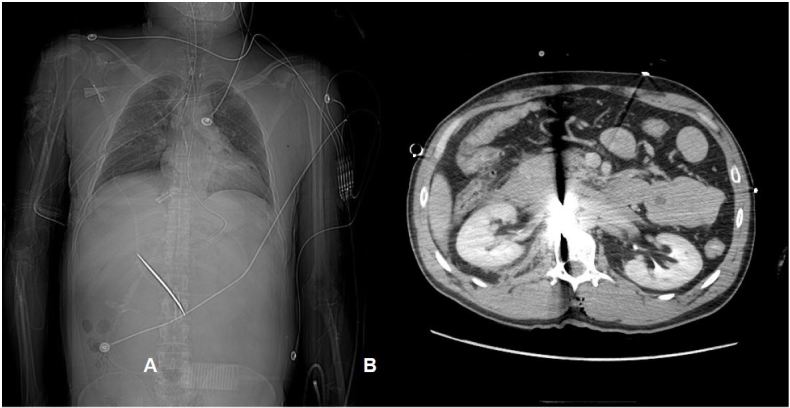| Author | Affiliation |
|---|---|
| Lauren M. Porter, DO | Lehigh Valley Health Network, Department of Emergency Medicine, Allentown, Pennsylvania |
| Robert D. Barraco, MD, MPH | Lehigh Valley Health Network, Department of Surgery, Allentown, Pennsylvania; University of South Florida Morsani College of Medicine, Tampa, Florida |
| Stephanie Goren-Garcia, DO | Lehigh Valley Health Network, Department of Emergency Medicine, Allentown, Pennsylvania |
| Jeanne L. Jacoby, MD | Lehigh Valley Health Network, Department of Emergency Medicine, Allentown, Pennsylvania; University of South Florida Morsani College of Medicine, Tampa, Florida |
A 42-year-old male was assisted from a car in front of our inner city stand-alone emergency department (ED) with a stab wound to the right chest. He was confused and bleeding; his past medical history was unknown. The patient was diaphoretic, pale and confused with a large vertical stab wound over his right chest with no other obvious injuries. On initial exam in the outlying ED, his back was obscured by blood. He was transferred to the trauma center where during a full secondary survey a 2cm wound was located over the patient’s lumbar spine. The patient was stabilized and taken for imaging. No focused assessment with sonography for trauma (FAST) was done at either site; however, the FAST exam, which emphasizes the search for extraluminal blood, would not have been expected to find a foreign body. Computed tomography (Figure) showed a retained 10cm blade extending through the left L1-L2 interlaminar space, spinal canal and disc space with associated injuries to the IVC and renal vein, duodenum and medial left hepatic lobe. On day one he had two damage control laparotomies. The blade could not be removed due to patient instability and inability to turn him prone. On day two, he returned to the operating room and the blade was removed by resecting the spinous process and lamina of L1 with joint efforts by the vascular, neurosurgery and trauma surgeons. He required five additional surgeries to wash out and finally close his abdomen and was discharged to home after 39 days. He was neurologically intact.

Spinal stab wounds with retained knife blades are uncommon in the U.S. A literature search revealed few case reports.1-3 Enicker et. al present a 12-year case series from South Africa where a majority had neurologic deficits consistent with Brown-Sequard syndrome.4 A U.S. case report presented a patient who presented four weeks after an initial stab wound to the spine with worsening neurologic deficits necessitating knife fragment removal.5 The importance of a complete secondary survey in the evaluation of assault victims in order to detect spinal injuries and possibly prevent neurologic sequelae is demonstrated in this case.
Footnotes
Section Editor: Sean O. Henderson, MD
Full text available through open access at http://escholarship.org/uc/uciem_westjem
Address for Correspondence: Jeanne L. Jacoby, MD, Department of Emergency Medicine, Lehigh Valley Health Network, 2545 Schoenersville Rd., Bethlehem, PA 18017. Email: jeannejacoby38@yahoo.com 12 / 2015; 16:1204 – 1205
Submission history: Revision received September 14, 2015; Submitted September 22, 2015; Accepted September 24, 2015
Conflicts of Interest: By the WestJEM article submission agreement, all authors are required to disclose all affiliations, funding sources and financial or management relationships that could be perceived as potential sources of bias. The authors disclosed none.
REFERENCES
1. Prasad BC, Vemula RC, Varaprasad G. Nonmissile penetrating spinal injury with an impaled knife: case report. Indian J Surg. 2013;75(3):237-238.
2. Amendola L, Corghi A, Cappuccio M, et al. Two cases of Brown-Séquard syndrome in penetrating spinal cord injuries. Eur Rev Med Pharmacol Sci. 2014;18(1Suppl):2-7.
3. Shahlaie K, Chang DJ, Anderson JT. Nonmissile penetrating spinal injury. Case report and review of the literature. J Neurosurg Spine. 2006;4(5):400-408.
4. Enicker B, Gonya S, Hardcastle TC. Spinal stab injury with retained knife blades: 51 Consecutive patients managed at a regional referral unit. Injury. 2015;46(9):1726-33.
5. Kulkarni AV, Bhandari M, Stivers S, et al. Delayed presentation of spinal stab wound: case report and review of the literature. J Emerg Med. 2000;18(2):209-213.


